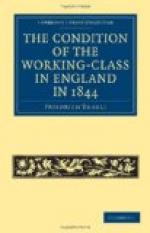Precisely the same state of things prevails in the factory towns. In Nottingham there are in all 11,000 houses, of which between 7,000 and 8,000 are built back to back with a rear parti-wall so that no through ventilation is possible, while a single privy usually serves for several houses. During an investigation made a short time since, many rows of houses were found to have been built over shallow drains covered only by the boards of the ground floor. In Leicester, Derby, and Sheffield, it is no better. Of Birmingham, the article above cited from the Artisan states:
“In the older quarters of the city there are many bad districts, filthy and neglected, full of stagnant pools and heaps of refuse. Courts are very numerous in Birmingham, reaching two thousand, and containing the greater number of the working-people of the city. These courts are usually narrow, muddy, badly ventilated, ill-drained, and lined with eight to twenty houses, which, by reason of having their rear walls in common, can usually be ventilated from one side only. In the background, within the court, there is usually an ash heap or something of the kind, the filth of which cannot be described. It must, however, be observed that the newer courts are more sensibly built and more decently kept, and that even in the old ones, the cottages are much less crowded than in Manchester and Liverpool, wherefore Birmingham shows even during the reign of an epidemic a far smaller mortality than, for instance, Wolverhampton, Dudley, and Bilston, only a few miles distant. Cellar dwellings are unknown, too, in Birmingham, though a few cellars are misused as workrooms. The lodging-houses for proletarians are rather numerous (over four hundred), chiefly in courts in the heart of the town. They are nearly all disgustingly filthy and ill-smelling, the refuge of beggars, thieves, tramps, and prostitutes, who eat, drink, smoke, and sleep here without the slightest regard to comfort or decency in an atmosphere endurable to these degraded beings only.”
Glasgow is in many respects similar to Edinburgh, possessing the same wynds, the same tall houses. Of this city the Artisan observes:
“The working-class forms here some 78% of the whole population (about 300,000), and lives in parts of the city which exceed in wretchedness and squalor the lowest nooks of St. Giles and Whitechapel, the Liberties of Dublin, the Wynds of Edinburgh. There are numbers of such localities in the heart of the city, south of the Trongate, westward from the Saltmarket, in Calton and off the High Street, endless labyrinths of lanes or wynds into which open at almost every step, courts or blind alleys, formed by ill-ventilated, high-piled, waterless, and dilapidated houses. These are literally swarming with inhabitants. They contain three or four families upon each floor, perhaps twenty persons. In some cases each storey is let out in sleeping




